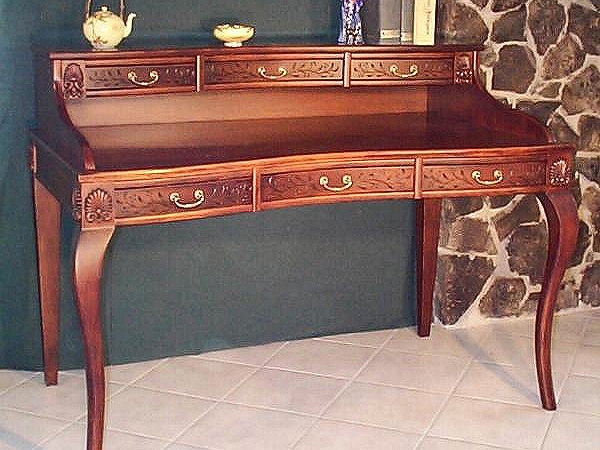
It’s pretty rare these days to see ornately carved, handmade furniture. Most of the work you see from professionals tends to be simpler and leaner than the old Chippendale and rococo furniture. Lee Grindinger, however, is doing his best to keep the style alive, combining the complex craft of great furniture building with the artistry of masterful woodcarving.
Lee had always been fascinated by the English and early American styles of carved furniture, so he studied and practiced and learned how to do it by hook and by crook. He learned how to build furniture during an extended vocational education, but learning how to carve it wasn’t so easy. “I just started carving and pitching it into the wood stove, and one day I carved a keeper,” he says. There weren’t any mentors, so he had to go by what he could find in books and by going through the drawings of the designers he really admired: Chippendale, Sheraton and Goddard.
The Industrial Revolution, says Lee, is what really tolled the end of the kind ofcarved furniture he admires. The English were doing great, intricate work and the Americans were doing bolder carving on this side of the ocean, he explains. “Then the Industrial Revolution came along and everybody tossed their chisels out the window and started designing around what machines could build,” says Lee. He describes the Industrial Revolution, at least in terms of furniture, as a huge cliff that most designers fell from. And the evolution of artistically carved furniture came to an end.
Well, Lee is trying to keep it alive, at least in his studio. He describes his work as a further evolution of the aborted trend in American furniture of bolder carving. He calls his style “deep relief” work, and it’s taken him a long time to develop his technique and his reputation. Trouble is, big furniture stores like Ethan Allen can do a lot of ornate carving with CNC machines and a lot of people who are unaware of the differences would rather buy it from the store-at about one tenth the price-than from a craftsman like Lee.
He bemoans the lack of education about furniture that he sees in the general public. Back in the last century, he says, most people would know a well-built piece of furniture when they saw it. Now, in our throwaway society, he says, we replace our furniture every 15 years. The heirloom mentality, where you bought furniture with the idea that you would hand it on to further generations, is gone. People don’t know that most of what they buy, as he puts it, “isn’t worth the particle board it’s made from.”
To be honest, he says, the Antiques Roadshow, the New Yankee Workshop and Roy Underhill have all done a lot of education about good furniture and that has helped.
And what he does is tough work. By combining carving and furniture building, he does the kind of work that exclusive woodcarvers would avoid. They tend to pick woods that are easy to carve, but Lee favors walnut, cherry and bubinga for his furniture construction-all are considered very tough to work with by carvers. But he doesn’t have the luxury of choosing his woods if he wants the piece to stand up to years of use, so he has learned to roll with the punches and keep his chisels very sharp.
The structure of the piece is also very important because he had to take into account the amount of carving he will do on each piece. “Actually, it’s quite a process to figure out what kind of structure you need, and then you start embellishing it. When you get into the more traditional stuff, you’ve got to see the skeleton underneath the skin because that’s where it all starts,” says Lee.
Unlike a lot of professionals, Lee has kept some of his pieces over the years. “My favorite client is my wife. She owns more of my pieces than anyone else,” he says. But that too is a mixed blessing. Some of his furniture from 20 years ago really makes him cringe because it was created when his skills were still pretty spare. He wants to take those pieces out to the woodstove too, but his wife won’t let him. And you don’t argue with your best client.
– Bob Filipczak





